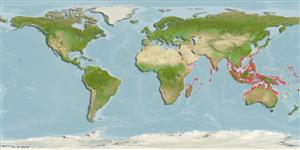Environment: milieu / climate zone / depth range / distribution range
Ecology
Marine; demersal; depth range ? - 17 m (Ref. 11441). Tropical
Indo-West Pacific: India and Sri Lanka to western Thailand, Sumatra and the southern islands of Indonesia, and northwestern Australia.
Size / Weight / Age
Maturity: Lm ? range ? - ? cm
Max length : 15.0 cm SL male/unsexed; (Ref. 9774); common length : 10.0 cm SL male/unsexed; (Ref. 9774)
Dorsal spines (total): 0; Dorsal soft rays (total): 65 - 70; Anal spines: 0; Anal soft rays: 49 - 52. Body brownish, with 1 ocellus above and below lateral line and 1 ocellus on posterior third of straight section of lateral line. Many indistinct spots and blotches on body. Pectoral fin on ocular side with 11-12 soft rays (Ref 9774).
Found on the muddy and sandy bottoms of the continental shelf. Feeds on benthic organisms. Sold fresh and dried salted in markets.
Life cycle and mating behavior
Maturity | Reproduction | Spawning | Eggs | Fecundity | Larvae
Distinct pairing (Ref. 205).
Nielsen, J.G., 1984. Bothidae. In W. Fischer and G. Bianchi (eds.) FAO species identification sheets for fishery purposes. Western Indian Ocean fishing area 51. Vol. 1. FAO, Rome. pag. var. (Ref. 3322)
IUCN Red List Status (Ref. 130435: Version 2024-1)
Threat to humans
Harmless
Human uses
Fisheries: commercial; aquarium: public aquariums
Tools
Special reports
Download XML
Internet sources
Estimates based on models
Preferred temperature (Ref.
123201): 25.2 - 29.2, mean 28.5 °C (based on 2471 cells).
Phylogenetic diversity index (Ref.
82804): PD
50 = 0.5000 [Uniqueness, from 0.5 = low to 2.0 = high].
Bayesian length-weight: a=0.00724 (0.00338 - 0.01553), b=3.17 (3.00 - 3.34), in cm total length, based on LWR estimates for this Genus-body shape (Ref.
93245).
Trophic level (Ref.
69278): 3.5 ±0.37 se; based on food items.
Resilience (Ref.
120179): High, minimum population doubling time less than 15 months (Preliminary K or Fecundity.).
Fishing Vulnerability (Ref.
59153): Low vulnerability (10 of 100).
